Gentle stretches and other low-impact movements can bolster the muscles that stabilize your knee joint. Begin with stretches for the heel, calf, quadriceps, and hamstrings, then progress to half squats, calf lifts, and various leg-raise drills.
Whether you’re an elite athlete, a weekend adventurer, or someone who walks daily, knee pain can interfere with activities you enjoy.
This pain may stem from:
- overuse
- osteoarthritis
- tendinitis
- bursitis
- meniscal tears
- sprained knee ligaments
Working out an injured or arthritic knee may feel counterproductive, but movement is generally better for the joint than immobilization. If you don’t move your knee, it can become stiff and the pain may worsen.
If your knee discomfort is related to injury, surgery, or arthritis, gentle stretching and strengthening routines can relieve pain while improving flexibility and joint range of motion.
Always check with a healthcare provider or physical therapist before beginning a new exercise plan. Most importantly, heed your body and stop right away if you experience severe pain or other unusual symptoms.
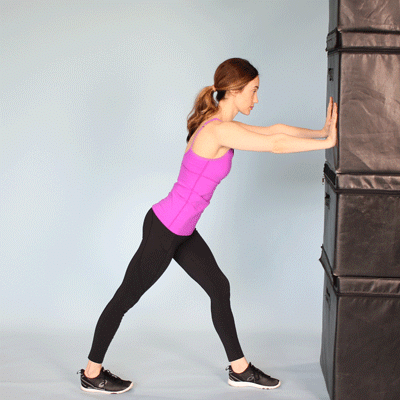
Strengthening exercises for knee pain
You can lessen the load on your knee joint by consistently training the muscles surrounding it. To strengthen the knee, concentrate on moves that target the hamstrings, quadriceps, glutes, and hip muscles.
4. Half squat
Half squats are a safe way to build strength in your quadriceps, glutes, and hamstrings without putting excessive strain on the knees.

How to perform this exercise:
- Stand with your feet shoulder-width apart. Place your hands on your hips or extend them forward for balance.
- Keeping your gaze forward, slowly lower into a squat about 10 inches — roughly halfway to a full squat.
- Pause briefly, then rise by pressing through your heels.
- Complete 2 to 3 sets of 10 reps.
5. Calf raises
This movement strengthens the rear of your lower leg, primarily your calf muscles.
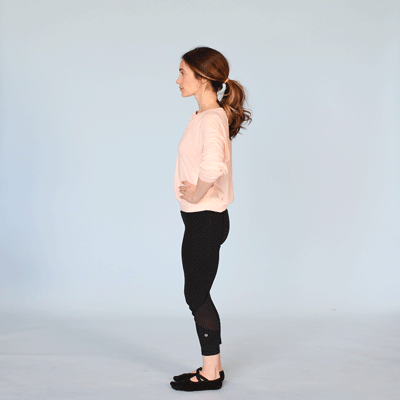
How to perform this exercise:
- Stand with feet shoulder-width apart near a wall or hold the back of a chair for support.
- Raise both heels off the floor so you’re on the balls of your feet.
- Slowly lower your heels back down. Controlled movement is key to strengthening the calves.
- Do 2 to 3 sets of 10 reps.
6. Hamstring curl
The standing hamstring curl focuses on the hamstrings and glutes, and it also engages your core to keep your torso and hips stable.
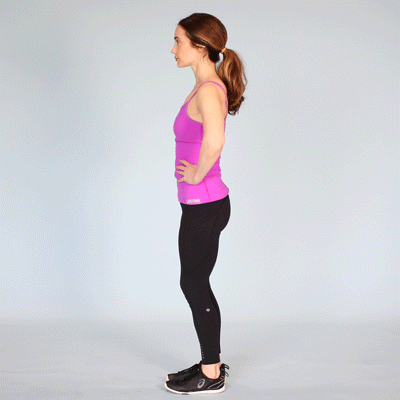
How to perform this exercise:
- Stand facing a wall or next to a chair for balance. Feet should be hip-width apart.
- Bend one knee and lift your heel toward the ceiling while keeping your upper body steady and hips facing forward.
- Hold the position for 5 to 10 seconds.
- Lower back to start.
- Perform 2 to 3 sets of 10 reps per leg.
7. Leg extensions
Using your bodyweight for leg extensions rather than machines reduces extra stress on the knee while strengthening the quadriceps.
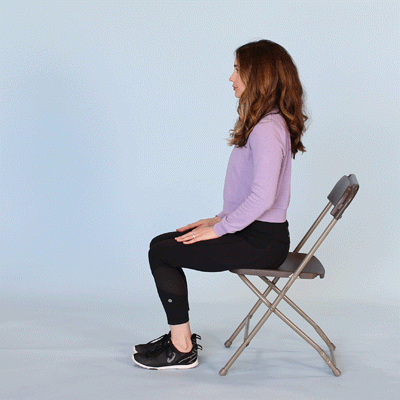
How to perform this exercise:
- Sit tall in a chair.
- Place your feet flat on the floor, hip-width apart.
- Looking ahead, contract your thigh and extend one leg as high as possible without lifting your hips off the chair.
- Pause, then lower back down.
- Do 2 to 3 sets of 10 reps per leg.
8. Straight leg raises
Straight leg raises target the quadriceps and hip flexors; flexing the foot at the top will also activate the shins.
As this movement becomes easier, you can add a 5-pound ankle weight and gradually increase resistance as leg strength improves.

How to perform this exercise:
- Use a mat to cushion your back if desired.
- Lie on your back with one knee bent and the other leg extended straight.
- Tighten the quadriceps of the straight leg and slowly lift it until it aligns with the bent knee.
- Hold for 5 seconds, then lower back down.
- Complete 2 to 3 sets of 10 reps per leg.
9. Side leg raises
This move strengthens the hip abductors. These muscles on the outer hips help with standing, walking, and rotating the legs; strengthening them can prevent and alleviate hip and knee pain.
When the exercise becomes easier, consider adding a 5-pound ankle weight and progressively increasing weight as strength grows.
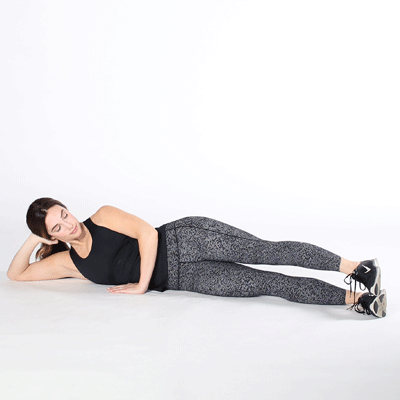
How to perform this exercise:
- Lie on your side with your legs stacked. Support your head with one hand and place the other hand on the floor in front of you.
- Raise the top leg as high as is comfortable. You should feel the effort along the outside of your hip.
- Pause briefly at the top, then lower.
- Do 2 to 3 sets of 10 reps on each side.
10. Prone leg raises
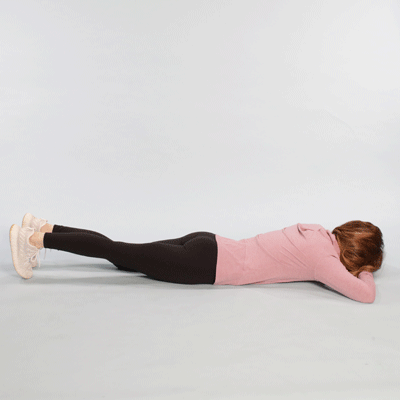
This exercise engages the hamstrings and glutes. As you progress, you can add a 5-pound ankle weight and slowly increase resistance to continue building leg strength.
How to perform this exercise:
- Use a mat for padding if needed.
- Lie face down with legs extended. Rest your head on your arms if comfortable.
- Activate the glute and hamstring of one leg and lift it as high as you can without pain, keeping your pelvis flat on the floor.
- Hold the lifted position for 5 seconds.
- Lower, rest for 2 seconds, then repeat.
- Perform 2 to 3 sets of 10 reps per leg.
Other types of exercise for knee pain
After you’ve increased knee strength, add low-impact activities to your routine. These typically place less load on joints than high-impact activities like running or jumping.
Low-impact options include:
- yoga
- tai chi
- elliptical training
- swimming
- stationary cycling
- water aerobics
- walking
Overall treatment plan for knee pain
Relief from knee pain depends on the root cause. Beyond home exercises, a clinician may suggest:
- Applying ice if it eases symptoms
- Wearing a compression sleeve to reduce swelling and provide support
- Using nonsteroidal anti-inflammatory drugs (NSAIDs), topical or oral, in the first days after an injury
Research indicates supervised physical therapy may be more effective than home exercises alone for reducing knee pain, so consider exploring local options.
A physical therapist can design and oversee an exercise program tailored to your particular injury or symptoms.
Frequently asked questions
Does walking help with knee pain?
Establishing a walking habit can strengthen and improve flexibility of the muscles around the knee. Start gently with short walks on a treadmill or flat surface.
You can gradually make it more challenging by lengthening sessions, increasing frequency, or adding a modest incline.
What exercises relieve knee pain?
Prioritize low-impact movements that target the muscles supporting the knee, such as hamstrings and quadriceps. Strengthening those muscles helps stabilize the knee and ease strain.
What exercises strengthen knees?
The quadriceps, hamstrings, and glutes all help stabilize the knee. Exercises that build these muscles include:
- Calf raises
- Hamstring curls
- Leg extensions
- Lunges
- Step-ups
- Squats
What is the single best exercise for knee pain?
The best exercise for knee pain is the one you can perform comfortably and consistently. The ideal choice also depends on the specific injury or condition involved.
If you have concerns, always consult a healthcare professional.
The bottom line
Doing stretches and strengthening exercises that focus on the muscles supporting your knees can reduce pain, improve range of motion and flexibility, and lower the risk of future injury.
If you have joint pain, consult a physician or physical therapist before starting an exercise program. They can suggest exercises and modifications tailored to your symptoms and underlying cause.
















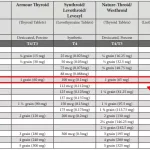

Leave a Reply
You must be logged in to post a comment.